Text
Nkuley Masemola and his iconic creative expressions

Nkuley Masemola is a multidisciplinary creative who works as a fashion model, DJ and stylist. Nkuley Masemola has modelled for iconic South African fashion brands such as Rich Mnisi, Thebe Magugu and Nao Serati. They also invite the young vibrant youth of Johannesburg to the eccentric scenes of Braamfontein through DJ’ing. With styling that transcends cultural eras and borders, Nkuley translates their experiences of navigating South Africa and the creative culture artistically into their photographs. The success they have garnered since working as a fashion model from the age of 17 is truly inspiring. In this interview we talk about what inspired Nkuley growing up, their artistic journey and the importance of being yourself in order to thrive in the creative industry.
1. How was it like growing up in Pretoria?
The funny part is that I didn’t actually grow up in Pretoria, it was more outside of Pretoria than it was Pretoria. I grew up on the outskirts of Pretoria - that’s the farms. Bronkhorstspruit is where I was from. And it was bland - I don’t know any other way to explain it. It was like growing up on a big sheet of white paper. I had to make out myself. It was an experience but it was also really overwhelming because no one there had progressed to anything. It was complicated but also a good learning curve. I always say I would have rather not. I would have rather had a soft life but I guess I see the benefit of growing up like that but it was overwhelming.
2. What are some unforgettable childhood experiences you believe shaped who you are today?
When I finally moved to Bronkhorstspruit, after my father passed on, my mom bought herself a huge mirror. I didn’t have friends, I didn’t have anyone. So the only thing I ever did was look into that mirror. I had all my performances there, I had all my interviews, I did everything with that mirror. I just became so self-obsessed, all of my art is self-obsession. Everything is all about me. It’s my self-portrait, it’s music that is about me, everything that is structured in a way that is like self-worship. So I think that particular childhood experience shaped me forever. I got harassed but I never got bullied. I never let anyone bully me. If it happens, I can just avoid it, I’m not gonna stick around. I was always inside the house. I would make up my own stories, live in my head, and wait for the day I move to Jo’burg. When it finally happened, I already had like self-discovered so much. That particular childhood experience shaped who I am today. I created my whole world, and now I’m living in it.
3. How did you start modelling?
Back home, there used to be this modelling agency. It was just high school kids who had high-quality cameras, more than it was a modelling agency. They were like, “Yeah you should be a model.” And I was like, “I guess.” It was never my thing. I take really good photos, but I don’t look like a model, I don’t present myself as a model. At that time, I wasn’t the typical male model. And so I was like I’m not a model. That happened and it wasn’t really serious. When I moved to Jo’burg, my friend and I had just come from registering and we were going past Kitcheners and my friend was with their friend. We were all speaking to a guy and he said, “Yeah you can just come back to my place.” We all went back to the place. Then I left my matric certificate at their place and then when I left and went back home, they were like, “You left your stuff here [matric certificate] and also, I saw on Twitter that you might have to drop out of school because you don’t have anywhere to live until March so you can just live with me.” This is the person that I met with a friend because they met on the streets of Braam, literally at the corner of Kitcheners. I lived with that person for 3 months. They literally got me into modelling.
The first day I got here they were like, “You’re a star!”. I was on a music video set, and they needed one guy and I had just moved to Jo’burg and put my bags down. My parents had just dropped me off. I put my bags down and went up to shoot the music video. After that, I had another job. It was quiet for a minute and then my friend asked me to escort them to a casting. Still, I was not in the modelling game, I was just deep in love at the time. So cool, I go to this modelling gig, and then when we get there, my friend doesn’t get picked but they’re choosing from outside. They’re like, “You? Come here.” I said that I’m not here to model what’s happening? They said, “No, just audition quickly.” So I walked and strutted to the wall and then when I came back I got picked. It was The Threaded Man show. After that, everything started picking up, everything just set off. That’s how that happened. I just started modelling after that. Still very weird.
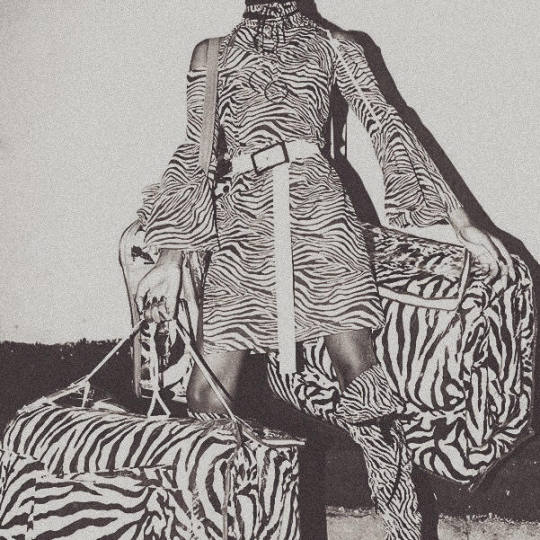
4. Wow! The Threaded Man was so huge at that time.
I didn’t even know. I didn’t know who Siya Beyile was. I had just got to Johannesburg. I had no idea who anyone was. So literally getting calls from Rich Mnisi being hey it’s Rich Mnisi. When I found out it was Rich Mnisi I was like OMG! They were shooting for i-D. That is one thing I’ve always dreamt about - I’ve always bought i-D magazines at the taxi ranks. When they said, "You’re 17 you’re gonna shoot for i-D", I was like that’s crazy, that’s crazy. I shot for almost every magazine that I had back at home. In one year, I had Cosmopolitan, Vogue, and i-D. My mom was like, “Aren’t these the magazines that are in your room.?” It was my favourite flex. I didn't even know it’s gonna happen in terms of modelling. I had always imagined being a part of the creative team or like one day when I’m all the way older on the cover of i-D for doing something. But not a whole documentary that is based on us. That’s so crazy, that’s insane.
4. Which would you say are your favourite fashion collections you have modelled for?
I really enjoyed the Rich Mnisi collections that I modelled for in the first year - I thought I looked really good in zebra print. Thebe Magugu gave me a suit and said “Do what you must with it.” That was really insane for me. Siyababa Atelier’s collection, Rich Mnisi’s collection and Nao Serati’s collection.
5. The South African creative scene has truly evolved over time, but there’s still so much work to be done. What do you think still needs to be done to move the culture forward?
I think South Africa needs to stop normalizing things and actually live in them. We need to stop trying to normalize things so much because we are othering them more than we think. We are othering people more than we think. We are regressing more than progressing. If we keep saying “Normalize trans women” - why? They’re women. Women are already normal. You don’t need to normalize women. It’s microaggressions like that. People don’t realize homophobia is just as serious as racism. The same way people are judging you because of your skin colour is the same way you are judging someone for loving someone. I think South Africa would be much better if they just lived in their truth more than trying to be these progressive people. We’ve been through so much, that we should know by now that we can’t risk having another revolution. We’ve revolved too many times. We’ve been traumatized too many times - we don’t need any more trauma. We just need to get that into our heads. We need to let go of the power game. The obsession with power in this country is a hectic obsession - that needs to be let go of.
6. How do you find the experience of integrating fashion, music and creative direction together to tell a story?
It comes easily because everything that I do is still self-obsession. Everything that I create is based on me so it’s not that hard. Self-awareness. It’s hard in that term that you know yourself so much that people want to digress you into this way. The only thing hard about it is people not understanding you and wanting to change you and who you are at that point. You already know who you are. Trying to accommodate everyone into your world because I’ve already said I am living in my own world, in my own space. In my own space, there is no need to accommodate other people. I think that’s the hardest part about it. It’s just me finding spaces for people in my world. In terms of navigating it, it’s always been me living out what I wanted to live out. It’s always playing music - when I DJ I play all the music that has registered with me. I’ve always been a Rihanna girl, I’m always going to play Rihanna. I’m always going to have the Rihanna aesthetic - the same way she does it. I’ve been studying Rihanna for the longest time in my life. The same way she does it. The same way she has this creative direction that goes into her music that also goes into her modelling - it’s really insane. That’s what I’ve always done. Rihanna, FKA Twigs, and FAKA do that in the most perfect way ever. That’s my thing.
7. If you ever feel a creative block during a project, how do you reconnect and channel your energy?
I like feeling things out. If it doesn’t happen then it’s not gonna happen. I was at a point where I was really depressed last year - I was at my lowest. I had never been that depressed ever in my life before. I told myself that I never want to feel like that ever again. For that to happen, I always have to be honest with myself. I have to know that I can’t do this right now. If I’m gonna go somewhere and I’m like okay you’re gonna have to model today but you don’t have the haircut. You look bad, you’re gonna feel bad and the pictures are going to look bad. So rather, we don’t do it. Rather sacrifice that and put me in a risky position but I’m not going to put something out there that I don’t believe in and don’t feel comfortable with. Being uncomfortable with something that’s seen by so many people is actually kinda crazy. It’s like uploading a picture of your pinky toe that you don’t like. I know people always say embarrassing yourself on the internet is being real, but that is always different for me. My realness is perfection. The real me is the perfect me.

8. Which creative material inspired you on your overall journey - it could be a book, film, exhibition, art collection - anything really.
Definitely seeing FAKA. Sitting down, talking to FAKA, and realizing that we have had the same life experiences. When I was 15, when I was a party girl - I still am, FAKA was like, “Oh you host this party called “Umrubisho” and I was like omg we used to host that party and FAKA was like we were always there. It’s so crazy how the Universe aligns like that - that’s insane to me. No one at that point understood what that meant to me but it just means to me my life is fine, I don’t need to worry about a lot of things. Life is just going to progress the way life progresses. I’m just going to get to where I need to get. A moment most pleasing to me was when FAKA was curating a Versace show. That’s so insane. That means anything is possible. That moment for me just sparked up everything. Thebe Magugu winning the LVMH Prize. Rich Mnisi doing Milan Fashion Week. Moments like that for me make anything. Moments like that for me are the most affirming.
9. Which brands and artists would you like to collaborate with in the future?
I’m not a big fan of Kanye but I really love Yeezy and the direction that it’s taking. As much as I’m working with Adidas, I would love to go deeper into Yeezy like that. Of course, I want to be a FENTY girl so, so, so bad. All the luxury brands - not necessarily as a model but as a muse nonetheless. I would love to be a DIOR girl, I would love to work with YSL but most mostly, I want to be a FENTY girl.
10. And lastly, which words of advice would you give to artists who aspire to manifest their dreams in this creative industry?
I would say be yourself. It’s not a joke, really be yourself. Everyone always says this, and it sounds corny all the time but really but it took me at least 2 years to realize, be yourself. Don’t fake it out, be yourself in such a way that even if you are being fake, you’re being fake in a way that is beneficial to you. You’re being fake in a way that is not going to hurt you in the end. You’re doing chaotic things but everything you do must be aligned with you. Everything you do must not come back and bite you. Everything you do must be something that you’ve always wanted to do. Be selfish as much as you can because being selfish just means being yourself and be selfish in ways that will still benefit you. That’s what it has always meant. Just remain yourself because that’s all you’ll have. People will come in and out, but you’re gonna remain with the same person forever - and that’s gonna be you. Take care of yourself, you know what’s good for you, you know what hinders you. You know what you need to do, so just do enough of that to keep yourself going.
19 notes
·
View notes
Text
Azania Forest on honouring her heritage through art
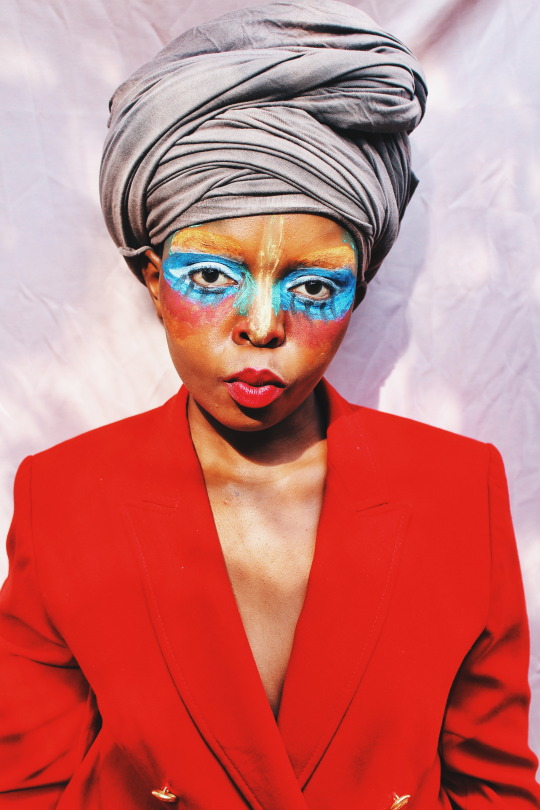
Azania Forest is a multi-disciplinary artist who expresses herself through visual art, photography, and fashion. Azania Forest draws inspiration from her multicultural background, traditional European fine art, and African heritage �� she tells these stories through her lens and adds her interpretations. True to her name, Azania meaning emancipation of Africa post-1994 and Forest being an infinite place of possibilities and exploration, she addresses various issues that plague our society such as South African inequalities, black women’s liberation through all facets, and preservation of culture.
She opens up critical conversations through symbolism in artworks such as Mbona Lisa and Lady Liberty, whilst still empowering us to own our narrative and tell stories that highlight the beauty of black women. Azania Forest intelligently intersects the impact that apartheid had on South Africa and encourages us to reflect to move forward with purpose. Azania enquires about her identity and makes sense of it all through every artwork she creates.
During our catch up over coffee, I learned about how she nurtured her calling, the themes central in her work, and how she uses her voice to create her legacy.
1. How did your experience of growing up in a multi-cultural family play a role in forming your identity? I am sure you are still drawing in so much knowledge from both your families?
My mum is Xhosa and then my dad is Tswana. My dad was raised Tswana but he doesn’t know his mother’s culture because she doesn’t know her father. They only know the mother's side. Those two are very different cultures because my mum is from the Eastern Cape and then my dad is from Gauteng. Just go going back home to my mom to visit her family is a different experience – even the scenery is different it’s not like visiting someone here in Gauteng like visiting my mom there in Soweto or my dad’s family. I have to go to the Eastern Cape frequently because she also has to see her family. It has made me so open and receptive to someone different from me. I don’t have a narrow view of a way of living or lifestyle. I have two contrasting cultures that don’t even sound alike – cultures that are not even dialect of each other. If someone is way different from me, it is very interesting for me to learn from them. It has made me open and receptive to identities, to other people who are not like me. I can say it has made me affluent culturally.
2. That is so beautiful. And you are probably still learning things about them from both sides.
I really am. I recently found out that my mom’s clan actually come from Khoi San. I realized even where they stay, is very dessert-like. It made sense, their landscape, and her lineage. So it was very interesting to find out where do they come from and how colonial the Eastern Cape and how influenced by colonialism the place is. With my dad’s side, I have a very shallow knowledge. I don’t go to where his great grandfather or grandfather grew up in. I always hear them talking about it – it’s in the North West, it’s also very dessert-like. Tswanas have a very Khoi thing about them. I am trying to trace both my mom’s and dad’s side. I am more fond of my mom’s side. It’s a responsibility I guess to search into that.
3. Why is preserving culture so important to you?
Preserving culture is important to me because if you don’t know where you come from, you don’t know your people, who birthed you – you have no sense of reference as to who you are. Your mother is you, your aunts – those are a part of you. You share DNA. If you don’t know where your people come from – there is a lack of knowledge about yourself. If my grandmother was an excellent teacher or nurse in her time, it gives me knowledge as to, “Oh if my grandmother could be a nurse, I can be a nurse as well because she’s a part of me, I’m a part of her.”
I get a sense of structure knowing who were the people that brought me here. That is why it’s important for me to preserve the knowledge that our great grandparents passed onto our grandparents and even to us. There are some traditions that Western medicine or technology can never truly grasp. Concepts, emotions, and the English language can’t describe them in the way your culture can. It is extremely important to preserve things like that. That makes who we are as a people.
4. I love that. It’s so important because I also feel like it’s so hard to trace back work that documents African spirituality, rituals, and customs. Whereas in the Western world that is so well documented in terms of philosophies and religions. When you come here, it’s so hard to access that.
It’s not in books, it’s not documented. That is our responsibility right now because we have access to printing books, writing books, language, education as opposed to our grandmothers who that was taken away from. It is our responsibility to preserve.
5. Congratulations on launching your fashion brand and being signed to an art agency in France. What inspired your decision to study fashion and how did you find that journey?
I have always known that I like creating. I like making things and also at that time, I liked fashion a lot. There was a change here in South Africa – the Braam culture and Neighbourgoods were forming, fashion was just so different. We had access to the internet, we could see what other countries were doing and how we can interplace ourselves in the world as Africans but in global people. That’s when I fell in love with fashion but as you grow you find yourself. What I realized is that I like telling stories so whether it be photography, painting, designing – l like to tell a story. That is why even when I do fashion, it mixes with art because I like to tell a story. I am not necessarily an aesthetic person (like beauty) I love that but I would rather have a beautiful story. Even if things don’t look good, but the story makes sense. If things look good and the story looks good – then wow, amazing!! [Laughing] I am trying to get there but my priority is the story. Telling stories through clothing and visuals – it’s a calling I could say, it’s my vocation.


6. Which themes are central in your art, photography, and fashion work? And how do you find navigating all of these mediums simultaneously?
The basis of all these 3 things is that they are visual things. It is things we see, and things we touch, things that exist. They are not only digital. That is my basis for connection for these things. If I make a dress, then I have to shoot. Then now photography comes in. And then now I want to exhibit it. Now take this creation into an art level. What makes it art is the story that you have about it. If you create something, you have a reference, you are communicating, you are expressing. That can translate into art. That’s why these things don’t live separately in my brain as different things. They live as one thing. I can’t separate them in my mind. If I’m telling a story, whatever medium I am using – it is still the same story. It’s just gonna look different physically. But the story in itself exists. So that’s how I join the 3.
7. I love the documentation of culture in Camagu studio. You incorporate all these diverse identities of black African womanhood into art. May you please tell me more about how it began?
I started Camagu Studio with Lulama Wolf. Camagu means to honor. The purpose of everything we do on that platform is to honor. To honor the people that came before us, to honor ourselves, and to honor our journeys - where we are going. It’s being present whilst acknowledging and appreciating all the things that have brought us where we are. Camagu is about that. You can see it in the aesthetic of our work – we mostly reference African images. What you said, unlike Western culture, documentation for us has been a very political thing. Taking pictures in the 1950s was political. White people would take pictures of us but through the colonial gaze, not to humanize us but to want to deconstruct us. It’s a double-edged sword because what they thought they were doing is destructive but they created archives for us to go back, analyze, and re-interpret today. So that’s what we do. We are self-reflective of where we come from and how we can materialize our thoughts and ideas. If it’s through art, we can do that. If it’s through photography, we can do that. It’s about honoring people and honoring our people.
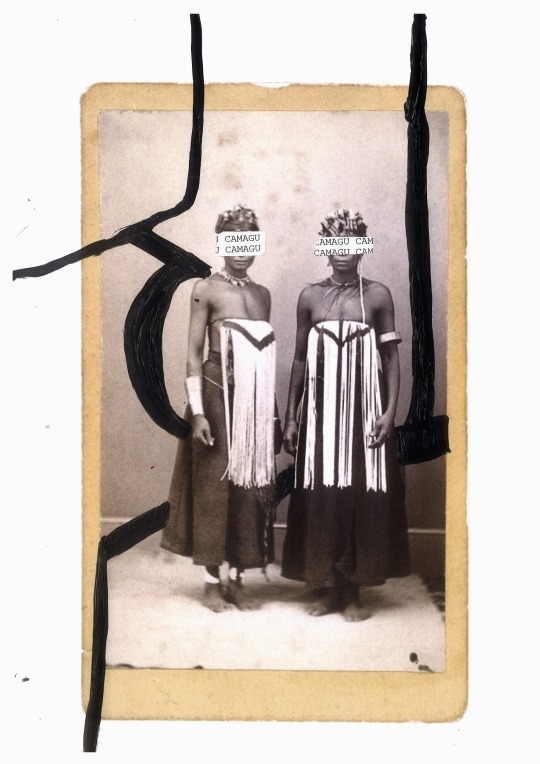
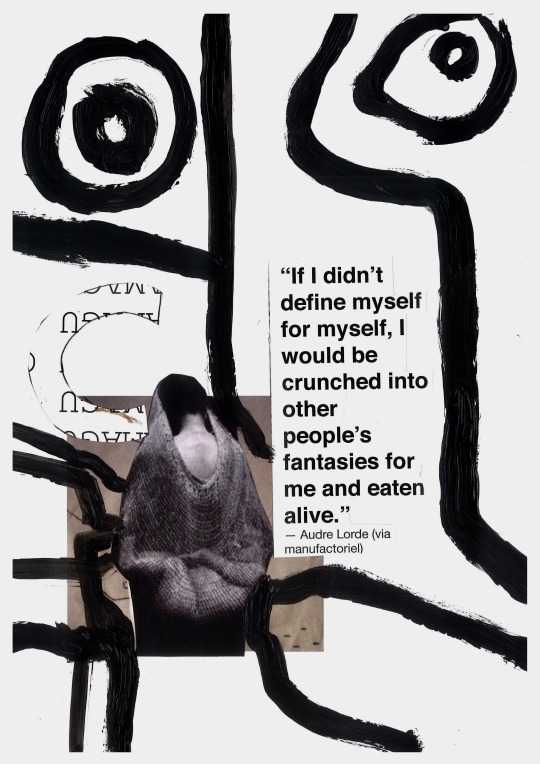
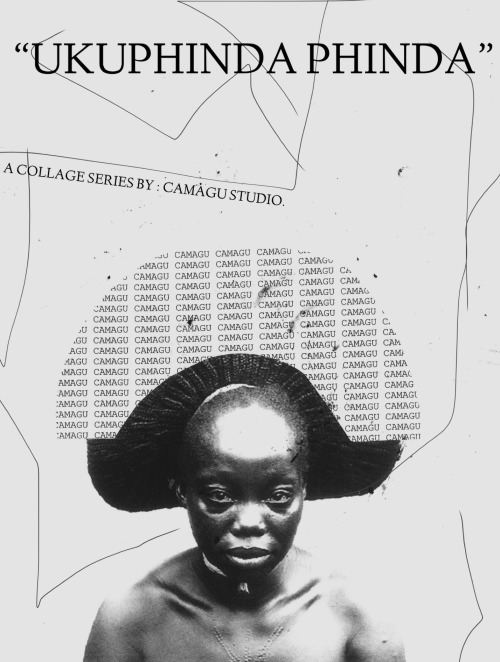
“Camagu Studio is a concept company that focuses on cultural research and artistic expression. The word ‘Camagu’ meaning ‘to praise’ or ‘to honor ’ in isiXhosa is the foundation of our cause. We learn from our own cultures and in turn, exalt how our heritage has given us the wisdom to pursue our modern identities as Africans. We are students of art and life, therefore, each product or service we produce will come from a place inspired by knowledge and appreciation. The heart of our studio comes from the ideation process. Each product or service comes from a story that is conceptualized and manifested, as a result, there is the intention behind what we offer. We are researchers, students, and storytellers.”
- Camagu Studio on Tumblr
8. Which would you say are your favorite works that you have produced?
Wow, that’s a difficult question because I have never actually looked into that. I do like my current works with Lady Liberty. I like Lady Liberty. I like Mbona Lisa which is an ongoing series, I am still working on it and expanding on the topic. Lady Liberty is also ongoing because it’s so layered and it needs to breathe and be spaced out with time. Currently, those are my top 2 because they are very personal to me. They are personal because I’m a woman, I’m a black woman trying to find my place in the world. I am growing as well. The world is treating me differently than when I was a teenager. Things are different now. I am also looking at the other experiences of other black women and merging that into one story. That is why this work is very important to me, and it’s a continuous thing.

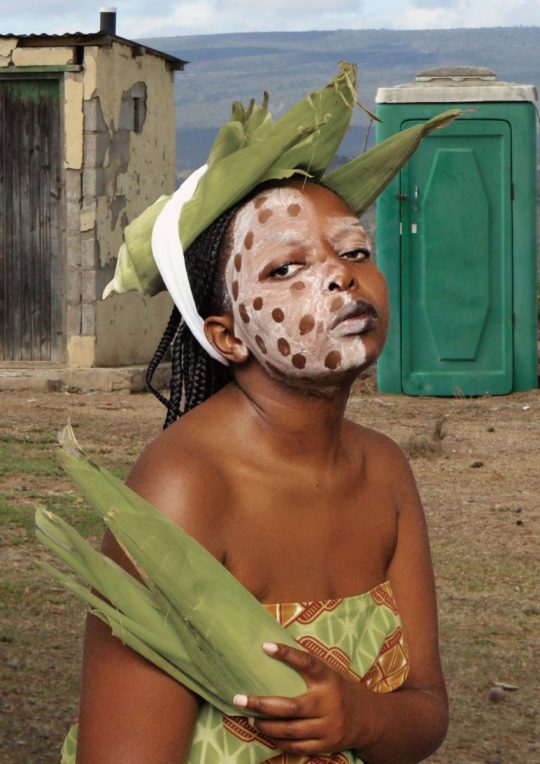
9. Lady Liberty was such an iconic piece of work and packed so much meaning that is important to unpack. How did you feel about the way it was received?
People will always have something to say and I understand. I just wish people would talk to me and communicate what their frustrations are so that I can help out where I can. But if someone is shouting, shouting, shouting, I can’t hear anything.
10. In terms of your photography, what qualities must a subject have for it to be captivating enough for you to capture it?
I was talking about this to a friend of mine. We were having this chat about photography and I realized something about the way black women are captured for magazines and media, thinking about athletes like Serena Williams. They are hyper-stylized, they are captured in what they do in the cover – “I’m an athlete”. If you look at how white women are captured – she could be an athlete or an actress, they will just style her basic: white t-shirt, hair, beautiful and nothing extravagant. I find that to be very interesting. I am trying to move away from how the media portrays black women. They never portray us as just women, I could be an athlete but I’m just an athlete. If I’m shooting this, maybe I could just comb my hair and wear a white shirt, that’s it Black women are always stylized, you must look extravagant, you must look like a goddess. All the time we are looking to make things extravagant for black women. For me, that’s a bit of a problem. It’s like the strong narrative – you remove that this is a person who is also vulnerable. Maybe they are not strong. We don’t portray things as they are when it comes to black women. What is interesting for me in photography is capturing black women as they are – nothing more, nothing less. The way they want to be perceived – that’s it, simple.
11. I have never thought about that before. When you say it, it makes so much sense. That is deep.
But you get to see it. We are always powerful. It’s a racial thing if you look at it deeply.


12. If you ever feel a creative block during a project, how do you reconnect and channel your energy?
I’m in such a creative space right now. I’ve been creating this entire lockdown, I’ve been making stuff. Which I guess, is how I got the agent because I was creating catalogues, and when you put in so much energy into something it just goes. When I have a creative block, I do have those days, I channel that creative block itself. If I feel demotivated, I use the demotivation. I don’t think I have experienced a block to be honest, because a block is when you’re not even sad or happy, nothing is coming to you. I haven’t experienced that, it’s going to happen maybe sometime. I just have pent up energy, I want to release all the ideas in me. I can’t say what to do in a creative block because I haven’t experienced it so far.
13. Which creative materials inspired you on your overall journey? It could be a film, book, exhibition, documentary, or anything?
A camera. That’s been my tool. That has kept me going and it started everything. When my mom bought me a camera, it changed everything for me. It saved my life. It’s the most potent weapon for me.
14. Which brands and artists would you like to collaborate with in the future?
A brand that I would like to work with is Comme des Garçons by Rei Kawakubo. I’d love to work with them with all my heart. I love Comme des Garçons and Alexander McQueen. These are fashion brands mainly. In terms of other brands, I really like Adidas. I like how they allow creative versatility. I would love to work with Adidas but on a real thing like designing a shoe together - not necessarily influencer only. But to create art and collaborate it with the shoe or t-shirt. So far I admire everyone doing art. The thing about doing collaborations is so tough because I am trying to find my voice and my place in the art world. I’m not really in a space of wishing to collaborate with any artists right now. However, I would love to collaborate with anyone who is not in visual art. Maybe someone who does music like instrumentals or dj’ing – that would be nice. As much as I do fashion, I would love to collaborate my art with someone else who does fashion like another designer or brand.
15. And lastly, which words of advice would you give to young artists who aspire to manifest their multi-faceted dreams in this industry?
As much as we take references on the internet, we see everyone’s work. We want to be like them, we want to copy them and we are inspired. I would advise everyone to take time to find the things that mean a lot them. Go offline, find inspiration outside of Pinterest. Look to your family album. Find the resources around you. Use what you have. Stay true to who you are. As much as there is education and all these beautiful references but there has to be a sense of grounding within you. You have to find what you like. Do I like it because everyone likes it and this has 2 million likes, now I also want it? It’s so easy to be swayed because everyone likes a thing but sometimes you find that I actually don't like it. I like it because someone else likes it. It’s that interrogation of finding what you like apart from the influence and then that gives you a platform to tell your story. When you are influenced by something else, you are guided by yourself. So if I’m going to be influenced by Coca-Cola which is something external from who I am, I will bring myself into Coca-Cola. That is my advice for any artist because, in the end, art is a story.
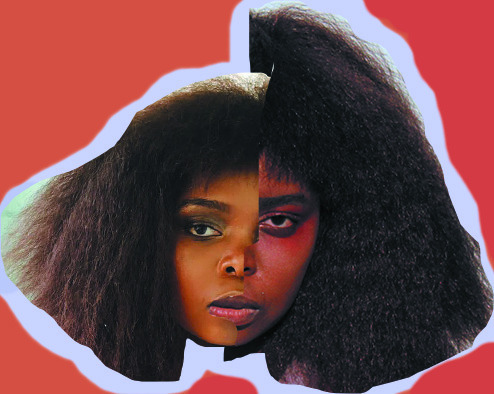
Image sources: https://outsidein.org.uk/galleries/lesego-seoketsa/, https://azaniaforest.tumblr.com/, https://icamagustudio.tumblr.com/, https://www.instagram.com/azaniaforest/
3 notes
·
View notes
Text
Reflecting on Solange’s artistic masterpiece, A Seat At The Table
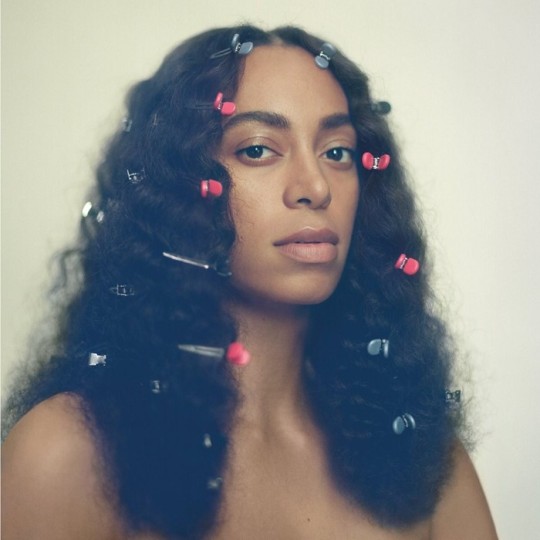
When I was at the of age 17, in my final year of high school, I listened to a few albums that were pivotal to my evolution as a black woman. These albums set me on a trajectory of understanding myself and the world I live in. One of these albums was A Seat At The Table by Solange Knowles. The album helped me make sense of so many things that I wasn’t able to articulate into words at the time. When I listened to the lyrics, it became an unspoken synergy between the music and my mind. The purpose of this piece is to reflect on this artistic and cultural masterpiece. With strikingly appealing visuals, that may make you overlook the depth it weighs, I unpack how it paid homage to black people, black womanhood and what inspired Solange on her journey to creating it.

It’s been 4 years since Solange Knowles released A Seat At The Table and it is more relevant than ever. The album was welcomed well and achieved great success in the industry such as the Grammy Award for Best R&B Performance for "Cranes in the Sky". However, it packs so much historical significance in an honest and relatable way. Solange paid homage to her roots and family’s history. She translates all of her life's experiences, frustrations, victories, views of the world into the art, and still gently encourages us to rise above it all. The way she was able to intersect the eras of her life and current social issues makes the album contemporary but still defies the limitations of time.
Through symbolism in her imagery and documentation of critical conversations in the interludes, she makes cultural references that urge us to go back and interrogate history. This is exactly why I love it when musicians revisit their origins because you have to decode the message and you can’t help but dig deeper which enlightens you. Especially if you didn't have the opportunity to traditionally study African history, art, philosophy, literature, or social anthropology – subjects which are the foundation of understanding our existence. Some of these conversations are painful and resonate with most of us, but we are forced to tackle them because they are in our spaces and are constantly woven into our lives’ phases.


Solange sings in a very harmonious and spiritual nature. It can be felt that Raphael Saadiq was the executive producer because the album has soul. And then some of the songs have an uptown funk groove. Solange draws inspiration from spirituality and metaphysics as we have seen in her overall creative direction.
The album has a lot of interludes in between the songs, which thoughtfully provide background and paint the scene of what inspired the song.
Solange sets the tone with Rise as the first song on the album - which I think is perfect that she began with that song because it’s about channelling your light. It almost serves as a metaphor for how she began rising above it all by writing this music. Rise begins softly while her words dance on the beautiful percussion. The central theme is not crumbling under the heaviness of the world, she motivates us to rise and prosper. It then moves on to Weary whereby she admits she is tired. She is tired of being strong and having to hold it all together. Even the way she pronounces her words, represents how weighed down she has been feeling, she expresses all these anxieties but in a way that sounds so heavenly. Solange then continues to narrate all of these pains in great detail on Cranes In The Sky. She documents her process of coping. She sings in such an angelic way you might even think she is trying to romanticize her struggles, but through all of these methods, she was still aspiring to be free. The more she tried to escape, the heavier she would feel. When she says, “Sometimes I don’t want to feel those metal clouds” , she yearns for freedom. Although the song is sombre, it offers solace to artists who often have to romanticize their pain in the virtue of creating art because, in the process of creating, they also heal others who are seeking a sanctuary.
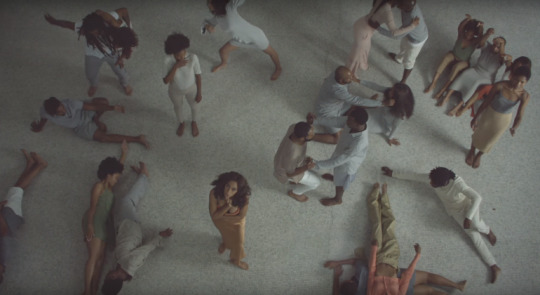
Don’t Touch My Hair and Mad address the way black women’s struggles are downplayed in society. Don't Touch My Hair is so relevant because we see our hair as our crown. People often feel so entitled to intrude and touch it mindlessly – sometimes without even permission. When Solange says “Don’t touch my hair”- it’s not just hair but it’s about so much more of our existence as black people. She and Sampha sing so softly, “Whatcha say to me? Whatcha say to me” and I love that part. She’s standing up and going “Hey, don't violate me, don't dehumanize me. Don't intrude my space.” When you have an encounter like that, you feel pulled in between the tensions of “Would my personality be perceived as overbearing, am I being too much if I reprimand people who make me feel uncomfortable. Or should I call it out?” Sometimes you summon the courage to call it out, and then sometimes you don’t call it out - just praying it doesn't happen to you again. So it's really powerful when she says that. She is taking control of her autonomy. She is communicating that it okay to set boundaries. The music videos for Don’t Touch My Hair and Cranes In The Sky have a dreamy and ethereal aesthetic.
We move onto Mad which features Lil Wayne. In Mad, Solange is saying don’t gaslight me when I speak of my suffering as a black woman. “Why are you always so angry?” Solange says I have a right to be angry. And it is highly justified. Just because it might be outside of your reality, it is my reality. So my pain should also be treated with the same level of urgency and preciousness as any other person. I have a right to be soft and delicate.
Throughout A Seat At The Table, Solange offers a sanctuary for black women while she uses it as an instrument to make her voice heard.

I also really appreciate how For Us By Us is a song for black affirmation. This art was made by us, for us. This is important because I believe nobody can tell your story better than yourself. She describes so many different microaggressions that black people face in society. She breaks them down in detail. Solange sings, “When you driving in your tinted car
and you're criminal, just who you are, but you know you're gonna make it far.” That was incredibly significant because it’s saying no matter how much you have been disrespected and you’re angry about it, you have a story to tell, you’re a child of the stars. You are going to make it far because your vision is larger than life, it’s larger than everything that tries to suppress your voice. Solange says you’ve taken so much from us – but why don’t you value us? And then The Dream sings, “Don't clip my wings before I learn to fly. I didn't come back down to Earth to die.” The message is don’t suppress my voice when I am trying to rise. However, we can even delve deeper into that because if someone clips your wings before you’ve learned to fly – they’ve taken away your power before you were even able to recognize it. So that you aren’t aware of your brilliance. And then lastly, the song I will discuss is Where Do We Go which is towards the end. Where Do We Go is a plea to repair our society. In the songs and interludes, she describes these issues and tensions but now she begs us to move forward by taking action to improve these issues. It is a crucial inquiry because ultimately we have to make conscious efforts to progress in the present and mold a better future. Nobody has all the answers, we are all trying to figure it out as a collective, but we can try every day. Her storytelling encourages us to rise above it all and accept that it’s okay to not have all the answers.

In a 2016 interview with Tom Breihan for STEREOGUM, Solange shared her inspirations for her album which I will now be unpacking in depth.
The killings of innocent black people in America under law enforcement served as catalysts for change. Solange made references to these events and draws in knowledge from her parents’ experiences as well. Solange revisited Lousiana and Creole for her healing and desire to connect to something bigger, and she ultimately was inspired by this pilgrimage.
Artistically, Solange was inspired by Mark Rothko’s collection at the Menil Museum in Houston, Citizen – An American Lyric by Claudia Rankine which is a book-length poem about everyday racial struggles in America. When I discovered this, I went back to read some of Rankine’s poems and she is incredible. She combines visual art, quotations from artists, and scripts. One quote by Claudia Rankine that stood out for me was "I love language because when it succeeds, for me, it doesn't just tell me something. It enacts something." When you read that doesn’t it just embody Solange’s vision with her album? She was also inspired by Robert Pruitt, Lynette Yiadom Boakim, and Fire Shut Up In My Bones by Charles Blow.
Musically, Solange was inspired by Syreeta Wright’s Black Maybe, D’ Angelo’s Africa,
Kanye West’s “We Major.” That influenced the sound of her horns and piano in the album. Vocally she was inspired by Master P and No Limit Records, Minnie Riperton, Tweet’s Southern Hummingbird and Lauryn Hill’s I Get Out. Many songs on the album encapsulate her soul-funk sound that characterized her music style from her early career.
Spiritually, Solange was inspired by Sun Ra and Alice Coltrane to channel a higher frequency in the album. Let me tell you something super crazy about these two Jazz composers. Their music is spiritual right, however, I didn’t know about Sun Ra. When I researched Sun Ra I discovered that his themes were afro-futurism, cosmic philosophy, and spirituality. The only Jazz composers I was exposed to whose music was spiritually influenced were Alice and John Coltrane. And in terms of poets, in South Africa, I was exposed to Credo Muthwa. So to come across Sun Ra was crazy to me because not only was he pioneering the Afro-futuristic school of thought, he also inspired Petite Noir and Rharha Nembhard – the Noirwave on their Afro-futuristic creative executions. Also what is super crazy is that Sun Ra was also born on the 22nd of May – which is my birthday! I mean – can this get more supernatural?
Afro-futurism is an entirely different ideology, and it could be a topic on its own but the fact that Solange can rope in these diverse teachings into her music is truly admirable. Overall, sonically the album is therapeutic – the way she arranged the songs and the harmonies - she pieces together all of the musical influences she loved growing up. I am sure she made every single person who contributed to it proud because she elevated to a different plane.

We don't fully understand ourselves - I don't think any artist does because by creating, you are trying to understand your world and heal from your pain. And it just so happens that others find healing in it too. Your journey is constantly unravelling. You read books, engage with art, have enriching conversations. You are forced to stretch outside of your comfort zone and spiral into new layers of awareness - all of these things shape you. And sometimes the only way you can move forward is by creating art.
Fundamentally, A Seat At The Table is an ode to black women. As younger black girls are growing up, we need to expose them to iconic works of this nature. So that they are empowered in ways that some of us weren’t growing up. It is one to be studied for generations to come because the themes are just that momentous.
A Seat At The Table is one of those albums that you have to revisit now and then. You know get some books that are classic masterpieces, you read them once. And then you engage with them again when you're a little bit older. When you read them again, it feels so new as if you have never read it before - and that’s simply because you are revisiting it with a richer understanding. You have gained new experiences and your horizons have expanded.
I hope I have inspired you today to revisit this album. If you haven’t listened to it before, I hope that you enjoy it and that you bask fully in that magical experience.
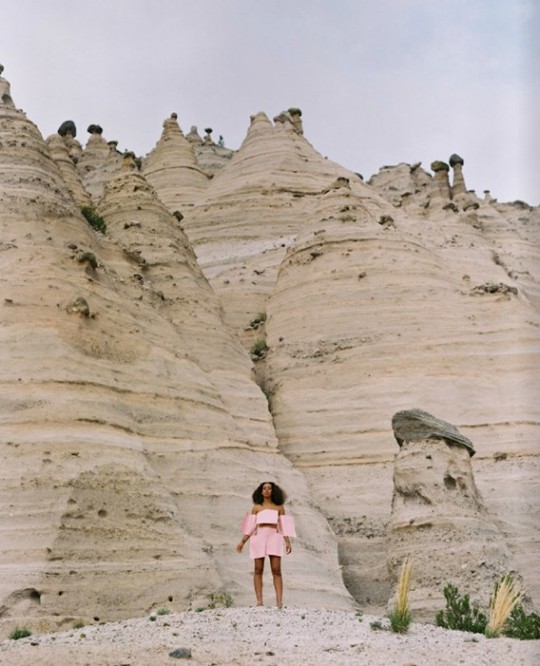
Images from the A Seat At The Table Digital photobook, courtesy of solange music. References: https://pitchfork.com/reviews/albums/22482-a-seat-at-the-table/
https://www.stereogum.com/featured/solange-shares-her-inspirations-for-a-seat-at-the-table/
https://www.solangemusic.com/
0 notes
Text
Justice Mukheli On Telling Authentic African Stories Through Art
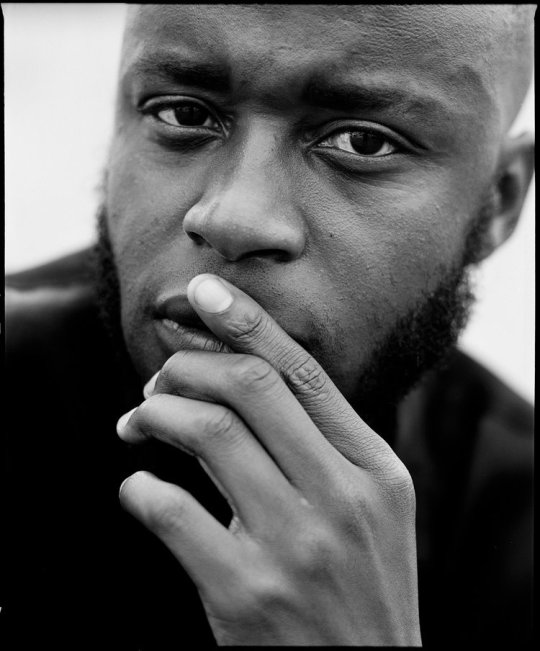
Justice Mukheli is a film director, photographer, and artist. Through his visual storytelling, he takes viewers through a journey of African stories that embody truth, power, and beauty. He documents everyday South African experiences through his lens which makes his art feel like home. It is evident that Justice Mukheli is rooted in his heritage as he draws inspiration from his upbringing in Soweto to enrich his work. Whether he is capturing on film or digital – his photography is full of soul, which can be seen through the eyes of his subjects. Art becomes a conduit for Mukheli to heal, breathing life into untold stories and contribute towards moving the African culture forward.
From working as an Art Director at Draft FCB to being a Commercial Director for Romance Films TV, how Justice Mukheli has constantly elevated himself through a plethora of creative mediums is truly inspiring. During our catchup in Rosebank over coffee, I learned more about his journey from advertising to art, how he achieved his tremendous success as well as his new path of being appointed the Commercial Director at one of the best production companies in the world, Romance Films TV.
1. How did growing up in Soweto inspire your vision of storytelling?
Growing up in Soweto inspired me in a lot of ways that are beyond the storyteller I thought I would become. The way we grew up and being a child at the time, Soweto was amazing. There was a freedom that kids don’t have – now that my life is this side of the world. Maybe on a weekend, I would just wake up and leave the house at 7 o’clock and go explore with my friends, come back before the sunsets. And it would be either from going to catch locust in the bush or creating our soccer field somewhere in the bush corner or playing under tunnels. We used to get under tunnels and walk. For example, we would get into a tunnel here, go through the tunnel, and get out in Bryanston. They were like a maze. There were so many activities as a kid. My childhood was amazing with memories and my parents were amazing. I was very close to my dad for the time he spent with us, close to my mum. She used to bake, we used to help her bake and knit. There was so much available to entertain me as a kid growing up in Soweto. There were these older gentlemen, friends of my uncles who dressed up incredibly beautiful and you grow up seeing that and aspiring to that. The car culture, sneaker culture, fashion culture – there was just so much.
2. What are some of the unforgettable childhood experiences you believe shaped who you are today?
When I get work or need to do or tell a story, I have a huge bank of resources and stories to borrow from, to look back into. I become excited about how I can bring those lived experiences into life, into the story I was trying to get. As a commercials director, when I get a brief most of the time, I look back there in my bank of memories. Have I experienced something like this? My latest commercial is about a funeral plan – this old man leaving his last message to his wife. So when I got briefed, it became immediately clear to me that I have experienced this. The point of view might have been different because I was a child but I can remember all those moments when my grandmother lost my grandfather and what happened and the nuance in how she was and how she dealt with the nuance of my culture and how we deal with loss. That was a huge and most incredible resource to go look into as a source of inspiration and borrow from. To breathe that experience into that piece so that it feels authentic. As a filmmaker and artist, we recreate moments and it’s in how close to reality we get. That’s my tool. It’s what I use all the time.

3. You recently joined Romance Films TV as a commercials director. How do you feel about this new path?
I am beyond excited about it. I wrote on my Instagram post that I have been inspired by Romance Films TV before I even thought that I would be a filmmaker. From 2009, when I got into advertising, I remember they would say to us when you write your advert you must write it for Grey Gray to take your script, to even consider shooting your ads for you. Grey Gray is a founding partner for Romance Films TV. He is incredible. He is an incredible storyteller. We used to write these ads and send them to their company. We would cross fingers that he considers our script. Unfortunately, when I was still in advertising I never got to work with him. Maybe our scripts were not good enough. It is exciting that the loop closed. I am excited to learn from them. There is Terence Neale who is incredible, he works mostly internationally. His ads are breathtaking, such as the ad he did for Beats by Dre. I have known them and had a friendship with them for a long time. It feels right to have joined them now because I have gained my own experience. I have scrabbled, built myself and built my confidence. I have proved that I can be a filmmaker. Now it’s amazing that I am part of a team that I have reached to be a part of for the longest time.
4. From working as an Art Director to being a Commercial Director, how did you navigate the transition from advertising to art and how did you own that space?
The transition was relatively easy. And I say this because advertising is an incredible teacher. Marketing teaches you how business works, positioning, and what you need to do to get a product to a certain target audience. I saw myself as a product when I started my journey as a photographer. Like okay cool, I’m a photographer. How do I get myself seen by those I want to book me? I had to build a portfolio using knowledge from advertising. I was in advertising for 7 years before I transitioned. My understanding of the industry helped my transition work seamlessly because I knew what to do. I knew the power of a portfolio, I knew how to get myself in front of the target audience that I need to book me. Owning the space was putting in the work and understanding what is needed to get myself to a position where I am considered or seen as someone interesting in my field or someone who has a different point of view or a different way of doing things. That is part of owning the space and creating work that is unapologetically my voice. And in the same vain, answering the client’s brief and aligning the brand with its target audience. And aligning the brand where marketers intend to get to. I make sure that my work is an extension of what my clients need. As a film director, I am a part of the chain.
Your voice is your own lived experience. For example, when I got briefed on Hollard, there were 2 other directors. There were 3 of us. It’s always important that I borrow from my lived experiences because it will be a unique point of view, a unique point of departure. After all, all the other directors will also come from their point of view, understanding, or lived experiences. That’s how they work and when I present my treatment it will unapologetically be me. It will have my voice, tone, and feels. With Hollard, the way I saw and experienced my grandmother grieve for my grandfather is unique to me. So I reconstructed and rebuilt that world from how I saw it.
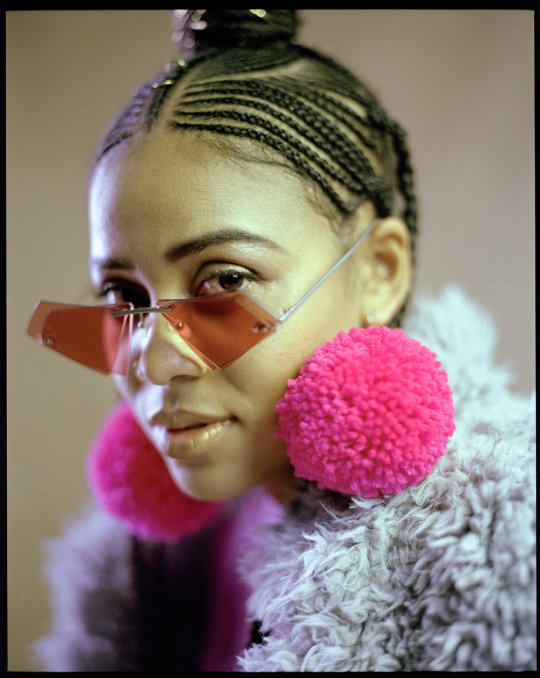
5. In terms of your photography, what qualities must a subject have for it to be captivating enough for you to capture it?
For me, it’s not about aesthetic qualities, it’s about the feeling I get from the eyes. It’s not an aesthetic thing. It’s mostly eyes and the feeling that I am trying to capture. My creative process is led by feeling rather than an idea. The idea is secondary to me. For me, the important thing is how does it make me feel. I have always felt that advertising teaches us that “idea is king” and I agree. But for me, the feeling is more important than an idea because you can get an idea but it doesn’t move you. The feeling is more important to me. Sometimes I use to gravitate towards kids a lot because it was a process for me to unpack my other lived experiences - emotions I never got to deal with acknowledge or immerse myself in. Sometimes when we go through what we go through, we are not present enough to go through the emotions of it and deal with it. Photography and film have become a tool I use as therapy for myself. I can tap back into a moment that is important to me and I deal with it, and I can capture that feeling.

6. In your tremendous career, which would you say are your favorite works that you have produced and why?
I love the Ingrams advert and the Hollard advert. There is an advert I have created for South African Tourism, it has a slightly different tone than the ads I am creating now. It was about portraying black people experiencing their land on these spaces that are mostly enjoyed by white people but enjoying them their way. I quite like the advert.
7. The advertising industry in South Africa has transformed in terms of how black culture is represented, however so much work still needs to be done to move the culture forward. What do you think agencies can do better in this space?
Agencies still fall into the mistake of not being mindful of black stories by black people, or at least having black collaborators in the chain of those stories being told. I think the industry very quickly falls into thinking that “ALL LIVES MATTER” type of mentality, that creative is creative. “What makes you think that just because I am a white person I won’t be able to tell a story in a sensitive way?”. I don’t think that’s the conversation. I think the conversation is telling the story most authentically and mindfully. I think advertising needs to create space for black narratives to be inclusive of black people from the process of creating it.
8. If you ever feel a creative block during a project, how do you reconnect and channel your energy?
I have a lot of creative resources and creative outlets. If my photography is struggling, I am going to paint. Now, I have decided that I want to paint again because I am not so inspired photographically. I am going to start to paint more. If directing or my other outlets are struggling, I can make music or I can sculpt, or I can write. I have a lot of outlets.

9. Which creative materials inspired you on your overall journey? It could be a film, book, exhibition, documentary, or anything?
It was a book by Malcolm Gladwell called Outliers. It speaks of the 10 000 hours rule and it touches on the people who are amazing that we love and follow. The people who inspire us decided to put in the work, it didn’t happen by chance. That book taught me that whatever I want to be, I can be. I can make that happen, no one else. And it can never happen by mistake.
10. Which brands and artists would you like to collaborate with in the future?
I would love to work with Netflix. And in terms of artists, there is an artist I like called Sibusile Xaba. He’s really amazing. That’s who I would love to collaborate with.
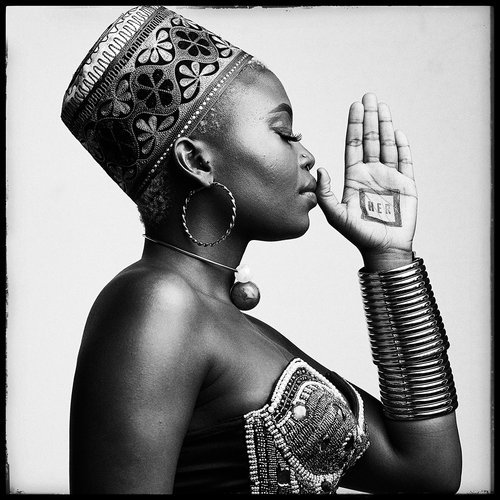
11. And lastly, which words of advice would you give to young artists who aspire to manifest their dreams in this multifaceted creative industry?
My last words would be what I just said about what I got from the book, Outliers – what you want to be, only you can make happen. Great people are not just great by mistake. It just doesn’t happen to them. It was a choice. If you want to be amazing at something, you need to decide to be. It’s a process, it won’t happen overnight.
Image sources: https://www.justicemukheli.com/work
Justice Mukheli Films: https://www.romancefilms.tv/directors/justice-mukheli
#SOUTHAFRICANART#thelifedocumentor#Zesintu Mgobhozi#lifestylebloger#African photographers#african art#justice mukheli
2 notes
·
View notes
Text
The Portrait Photography Series
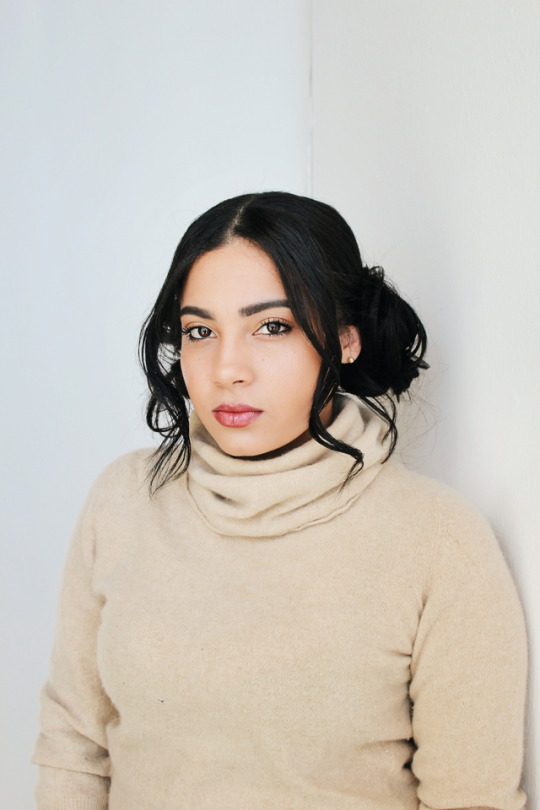
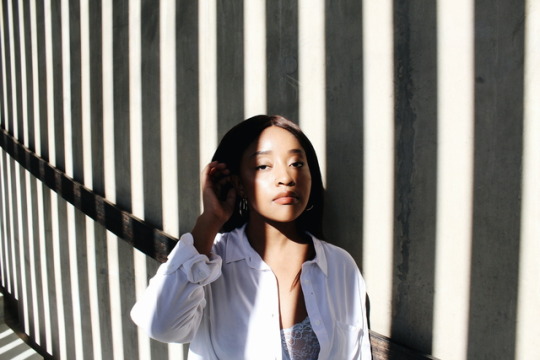
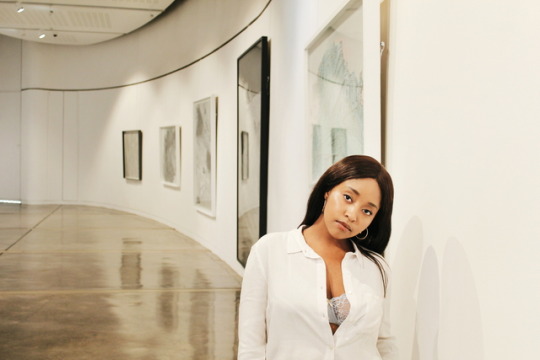
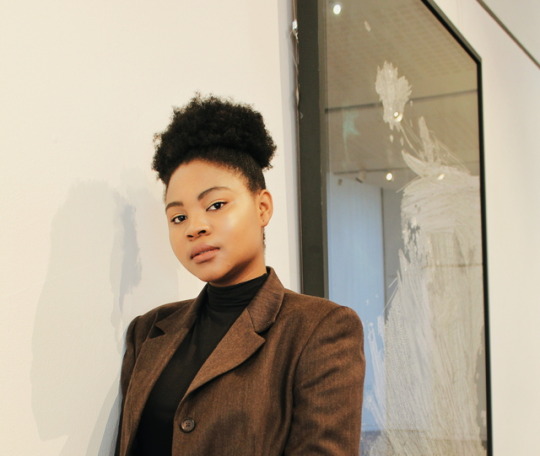
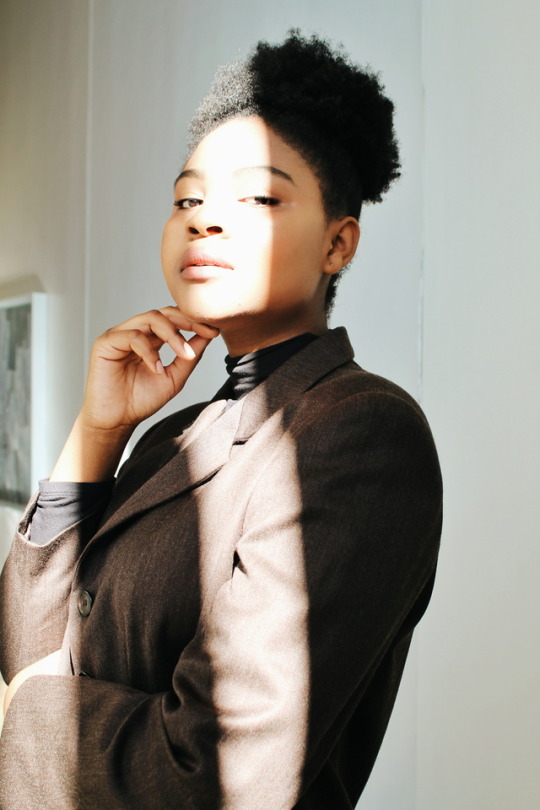
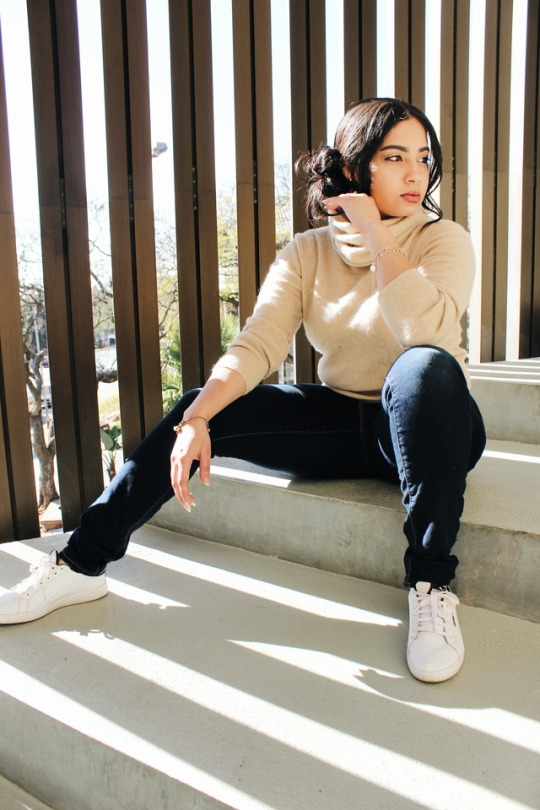
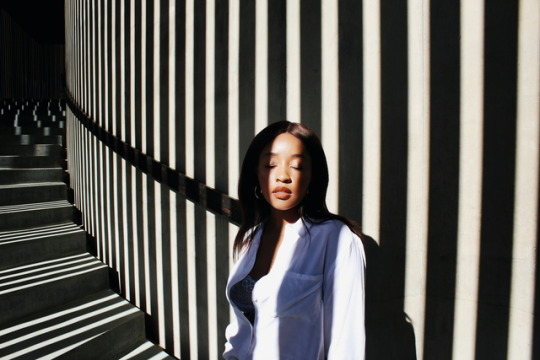
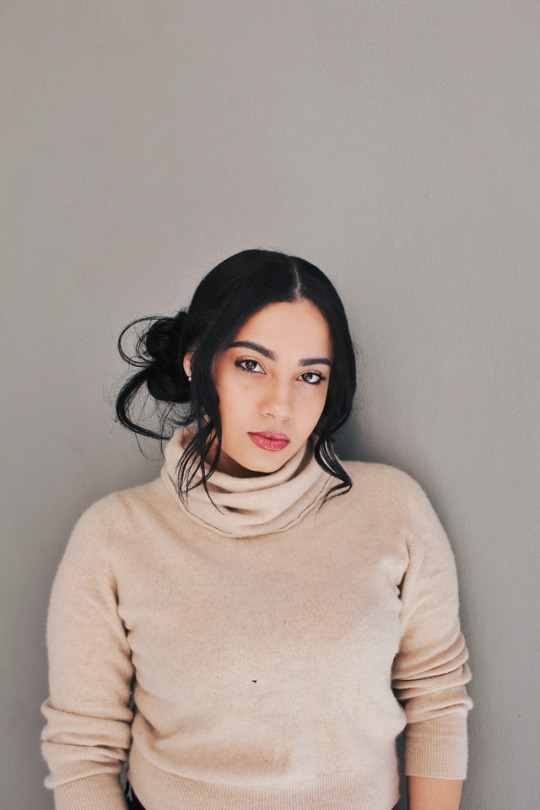
1 note
·
View note
Text
Trevor Stuurman - Telling Stories Through Style

“Fashion is a personal and powerful medium to express things greater than myself.”
Trevor Stuurman: global African, innovator, and artist. He encapsulates the essence of Africa in his work, challenges the way in which Africa is portrayed and tells the story of a continent that is moving forward – striving to always highlight its beauty and power. The Stuurman Style Diary is a platform whereby he showcases African style and everything that inspires that style. From representing Africa at Patti Imagine in Italy, to photographing AfroPunk for British Vogue and being a panellist at the Black Portraitures Conference hosted by New York University and Harvard University - Trevor has grown to reach new heights beyond the imaginable.
Trevor was born and raised in Kimberley and admits that he was inspired by his upbringing. He started defining his passion at an early age. “I cannot remember a time when fashion was not a part of my life. Growing up I was always creative.” It is manifest through his craft that he has a strong sense of self and his roots.
Today, Trevor Stuurman is not only known as a photographer, but as a creative director and style consultant as well. As a student of Film at AFDA, winning the Elle Style Reporter Search in 2012 at the tender age of 19 played a significant role in propelling his career. “It was my first job so it allowed me to save up to buy my first microphone; it allowed me to travel the world. It gave me exposure within the Elle Magazine. My first trip to London was with Elle.”
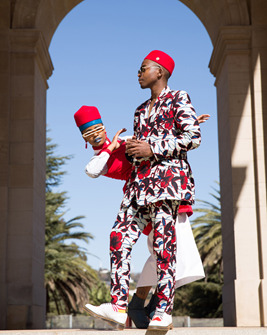
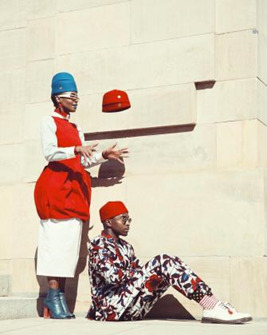
His photography - which always emanates a blend of vibrant colours, fascinating textures and cultural diversity – is a reflection of who he is. It is evident that all of his subjects resonate with his identity. He says with assurance, “It is part of storytelling so it’s always important to document it and it is even more important to document it from a personal point of view as opposed to a second-hand reference. African art and fashion allows me to do that.”
Trevor says that all the works he has done are memorable to him. “I don’t see them as individual pieces but I see them as a body of work. Collectively, everything amounts to something as opposed to one standout.”
When asked if there was any creative material he was exposed to in the past that played a role in shaping who he is today, Trevor says he was shaped by everything. “I’m so multi-faceted; I can’t pinpoint one piece or one medium that shaped me.” He adds with a smile on his face, “I do it all. I’ve been shaped by everything – every little exhibition I visited, every song I’ve listened to, every travel – it’s a collection of everything. I don’t think we can narrow it down to one body of work because I’m not genre-specific, I’m not medium-specific.”
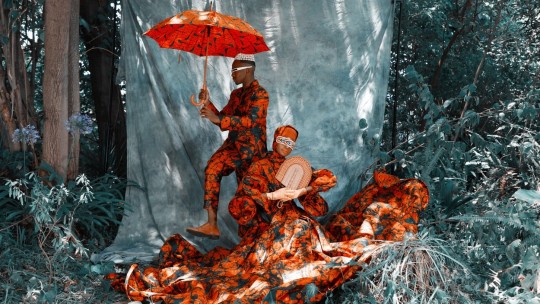
Trevor’s career has afforded him the opportunity to explore all around the world, from our very own African cities, to New York, Italy and London. He admits that traveling has made him gain new perspectives. “I don’t think you can ever travel and not change. It just allows you to see the world from a different lens. It allows you to appreciate and value life better. Value life as it is or as you understand it.”
Many upcoming creatives grapple with preserving their creative integrity while aspiring to meet brands halfway. When collaborating with brands, Trevor strikes a great balance between sharing meaningful stories as a creative while meeting the brand’s expectation. “It’s important to put your foot down, to always establish that. You also have the choice to choose what brands to work with instead of always feeling disempowered. You choose as opposed to other way where you feel thankful for being chosen to collaborate with them. So it’s about taking yourself as serious.”
Trevor has accomplished so much in a short space of time. But he is still motivated and driven to do more. “I don’t see myself accomplished a lot yet because the dream is still so much bigger. Once you’ve achieved something, it’s done. Then it allows you to dream bigger. It’s not about what you’ve done before; it’s about what the future holds.”
Trevor still has bigger aspirations such as working with the newly appointed artistic director of Louis Vuitton Menswear, Virgil Abloh. “I would like to see myself partnering with Virgil Abloh and Mary Sibande [a prolific Johannesburg-based artist].”
Trevor’s message to aspiring creatives is that they must find their voice. “Find your voice, nurture it and protect it. Your voice is your weapon and it is what sets you apart. Therefore it’s so important to be aware of that - what am I trying to say and how am I saying it. So it’s always so important to be aware of that.”
He concluded ,“Live a life that is of value and value to others.”
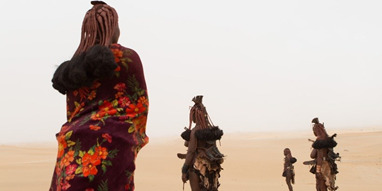
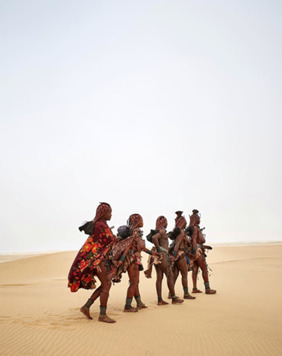
Images courtesy of: www.instagram.com/trevor_stuurman
#trevor stuurman#zesintu#stuurman style diary#dear ribane#thelifedocumentor#lifestyleblogger#visual art#african photographers
4 notes
·
View notes
Text
Kenny Jules Morifi-Winslow - The Third Citizen
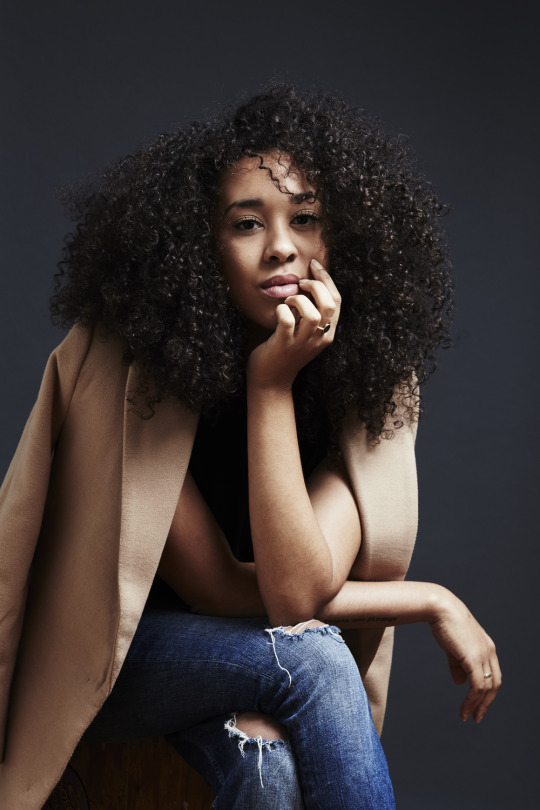
Culture. Fashion. Design. Art. These are the realms of expression that peppered our chat over coffee in Johannesburg’s upwardly trendy Rosebank. Kenny Jules Morifi-Winslow is a South African creative who has dedicated her career to the study of culture, fashion and art. A fashion anthropologist and Master’s graduate from Parsons School Of Design, Kenny writes The IIIRD Citizen. Her lifestyle blog integrates academic essays, creative writings and poems that contribute towards opening critical discussions. On The IIIRD Citizen, Kenny expresses her passion for culture and fashion through literary works .She inspires her readers to look at the concept of fashion beyond the visual appeal while ensuring she stays current by publishing the latest reviews from the fashion, design and food industry.
In the following interview, Kenny shares what exploring different countries was like throughout her childhood and the reason why being educated about culture and society is so important to her. Most significantly, she discusses the factors that played a role in shaping who Kenny Morifi Winslow is as we know her today.
I KNOW THAT YOU’RE PASSIONATE ABOUT CULTURE AND FASHION BUT EXACTLY WHO IS KENNY AND WHAT DRIVES HER? That is like asking how long a piece of string is, it depends. I think as people we are in the same way as culture – ever changing and ever evolving .The person I was is not the same person I am today based on the experiences of yesterday and the experiences of today. I am a passionate person, I think I’m a little bit volatile because of it, a bit intense, I think I’m grounded , I like plans and organization. But I’m also a dreamer in a sense that I don’t confine myself to the limits of possibility, of thinking. And I’ve proven that to myself in achieving all of those typesets so I have no reason to doubt that. So yeah: grounded, dreamer, believer, passionate, intense, and curious.
HOW HAS PHILOSOPHY AND ANTHROPOLOGY INFLUENCED THE WAY YOU SEE LIFE?
I always wanted to study Fashion Design but my parents weren’t keen on it. My dad wanted me to study law. So first degree I was accepted for a straight LLB at UCT, I arrived at registration day and I was like I actually can’t do this. This is not who I am, I’m going to be miserable and I switched to Anthropology, Artistry and Media. Anthropology at its core is a way of thinking, it’s a way of looking at the world, and it’s an interrogation essentially. Anthropology teaches you how to ask questions .And I think that had a very strong influence in how I approached fashion in general because it was so important to me. I wanted to do so much more than just make it, I wanted to understand it and I wanted other people to understand it, and to recognize that it is not as simple as putting on a t-shirt and glasses. There are so many questions you can interrogate about a single product that I have taken upon myself to ask about the fashion industry as a whole. It’s a cultural statement. It’s identity, its politics, it is everything.
YOU HAVE A VERY UNIQUE SENSE OF STYLE. WAS IT FORMED AS YOU DISCOVERED YOUR IDENTITY OR IT’S ALWAYS BEEN A PART OF YOU?
In my youth I was a lot more playful when it came to my clothing, more colour, I took more risks. I still wanted to look cool without thinking too hard. That was reflective of the stage I was in my life. It’s very easy to be carefree when you’re a student. Going to Parsons and moving to New York City by myself was an emotional rollercoaster. I had to grow up very quickly with that experience. By attending one of the top fashion schools in the world you’re exposed to so many more influences. The older I get, the simpler my style becomes because I start to understand things like quality, what luxury actually means and what style actually means. Trends mean absolutely nothing to me. I still have things in my closet from when I was 16 and things that my mom wore when she was 21 because they are timeless classic pieces. If you focus on shape, fabrication and the way things are made, then the time period you’re wearing it in or even what color it is doesn’t matter. You can always work it into your wardrobe. My style is at its core influenced by the things I studied. Art History teaches you how to think about proportion, shape and color. Anthropology influenced the way I think about how my clothes are made, where my clothes are made and what my clothes are made out of. And then my Master’s Degree was the mix of both. It taught me about sustainability, ethical production and cultural significance. It taught me how the choices I’m making impact my identity, what they say about my identity and how the rest of the world interacts with that.
YOU HAVE LIVED IN CAPE TOWN, LONDON, JOHANNESBURG AND NEW YORK. WHAT WAS THE EXPERIENCE OF NAVIGATING ALL THESE CITIES LIKE?
Wow, I could write a book about it. London is where I grew up. That is where I spent the majority of my life. From London it was Johannesburg then Cape Town for 4 years and then it was New York. Navigating those spaces was wild from a racial perspective most prominently. In London I went to an international school. It was a small diverse group with people from all over the world so we were exposed to a lot of cultures and I wasn’t weird. Then I moved to Johannesburg. Being mixed race had never been an issue until I came back to South Africa as a teenager. People started calling me coloured and they couldn’t understand why I don’t speak Afrikaans and I’m trying to explain that I’m not colored. That was kind of tricky. And then Cape Town of course – the majority of my friends and my social circle are black. Cape Town is a very white city so were always very conscious about the spaces where we were safe, welcome or unwelcome in. The racial divide in that city is unreal. And then I moved to New York where mixed race people are considered black. I was there at the time when Black Lives Matter movement was at its peak. I feel like I became a staunch defender of my blackness. Moving to New York and learning about these things made me feel like I am black because as much as I benefit from privileges such as Colorism because I’m light-skinned and I have good hair, I win in that way. But at the same time I am still prejudiced in the same way that a lot of black people actually are. So why not fight for those struggles instead of just defending my privileges? But you learn to adapt quickly. The move from South Africa to London which was the first big move really taught me how to navigate spaces and then moving every time after that became easy.
I LOVE IT WHEN YOU SPEAK ABOUT PARSONS SCHOOL OF DESIGN. YOU SPEAK OF IT WITH SO MUCH PASSION. HOW HAS PURSUING A MASTERS IN FASHION AT THIS INSTITUTION OPENED YOUR MIND?
My Masters programme was only 5 years old in the world and this particular course was called Fashion Studies. It had only existed for 5 years and they only accepted 30 people a year into this programme. What was really special about that particular programme is that you don’t have to have a background in Fashion. I was in class with people who had Politics degrees, economic degrees and people who came from Development backgrounds. Then we would all sit in class and have to apply our individual knowledge skillsets to this one topic. I think one of the most incredible experiences was the resources that people are. It completely changed the way I think about the work that I do. The resources I had at my disposal were unbelievable, absolutely incredible. New York City itself is a resource; the books, the museums and the galleries – incredible. So I think it completely changed the way that I think about what I do in the sense that people ask all the time, “what do you do” and they expect one job like I’m a banker or I’m an accountant. What Parsons taught me in particular is that there is no way to define the thing that I do now is because it has so many angles and facets.
WHY IS SUSTAINABLE FOOD AND DESIGN SUCH AN IMPORTANT COURSE TO YOU?
On a global scale, we have done a lot of damage to the environment. Capitalism has done a lot of damage to the environment and being conscious of it is a way to remedy some of that damage. I think it is especially important in developing economies like South Africa because it presents an opportunity for us not to make the same mistakes as developed countries. We can develop at the same rate without making the same mistakes. If we can build an economy that is already ethical and focused on sustainable production then by the time we become as big or as powerful or as rich as America, we don’t have issues like wage gaps, gender pay gaps or carbon emissions. To highlight those issues is to learn from the mistakes of the developed nations and prevent them in developing nations. It’s always a juggle between my world and my life in the first world where it’s about how do we reduce our emissions, how do we limit our impact on the environment. And then I come here and it’s about what are the ways moving forward we can achieve the same thing without making that mistake. How do we avoid genetically modified products? How do we avoid outsourcing our production systems to places like China and Taiwan? By building those production systems here, you circulate the money, wealth and the production to keep the entire supply chain local and we stimulate our own economy in the same way that China did. Then we run into whole new issues because China has issues with chemicals leaking into the environment and now there’s a chemical impact on the environment. There are so many plot points we need to identify and I think sustainability and ethical production in designing and food - particularly in South Africa - are the ways that we ensure a healthy growth process for the economy.
AFRICAN FEMINISM IS A TOPIC YOU HAVE HIGHLIGHTED IN YOUR PREVIOUS WORKS. WHAT DOES IT REPRESENT TO YOU?
It is important for us to have our own brand of feminism because feminism as we understand it is a very white concept. White women are very happy to fight for gender but never for race. They become two different issues for them. Whereas for black woman in particular it’s not one or the other, it’s both all the time. We need to start unpacking for ourselves what that means – what black feminism means what it means when we talk about each other’s hair textures and when we number them or when we tell girls who wear weaves that its synthetics and you’re not natural or why are braids and dreadlocks more highly respected than weaves and relaxed hair. Those are topics that are so unique to us and we sometimes overlook what that does to black womanhood. A lot of people aren’t honest about the thoughts that they have and if we don’t talk about them we can’t fix them. It’s really important for me to champion black feminism especially because it’s a fight our mothers didn’t get to fight and it has fallen on us now because we have the voice and we have the platforms to be able to talk about these things. I have a platform with an audience so why not talk about the real stuff?
WHY IS CULTURAL APPROPRIATION A DEBATE YOU FEEL STRONGLY ABOUT?
The problem with cultural appropriation is power. People think that it is about “creative integrity” and “this thing belongs to us and doesn’t belong to you” – no, it is about power. It’s also important to trace the history of things we think belong to us. Shweshwe print was given as a gift to King Shweshwe. It didn’t come from us; we just adopted these things and made them apart of our culture. The problem is when they take it back from us; make money off of what we have created now as our culture without referencing the process of how we got there. Cultural appropriation is such a tricky debate and there is so much grey area when it comes to cultural appropriation that we have to interrogate. That is the point of things like anthropology, the point of the work that I do. It is to go a little bit deeper and take it one step further. When we claim wax prints –who brought wax prints to Africa? Vasco da Gama is a Dutch company and they brought that stuff here. We didn’t make them we just claimed them so whose culture are we really appropriating? But the difference with that is it was never part of Dutch culture, it was part of the Dutch economy. And now we have the difference between culture and economy which we have to define and that filters into so many conversations about food and politics. Cultural appropriation is deep. People think fashion is frivolous-no, it’s a cultural history of a people or a person or a place.
HOW DO YOU FEEL ABOUT THE SOUTH AFRICAN OR AFRICAN CREATIVE INDUSTRY AT THE MOMENT?
I think we should separate South Africa from the rest of the continent because there’s a lot of amazing stuff happening in countries such as Nigeria and Kenya. And the thing that they have that we are lacking is patriotism in our designs. They believe in their own work, aesthetic and style. They produce it themselves and it has a very unique perspective. I love that. But I think South Africa is still struggling with replicating international designs or styles instead of creating our own. Especially when it comes to street wear labels; it’s just copy & paste of international street wear labels. But then if you think about things like furniture design, we’re really excelling in things like that because we are the home of those natural resources. Therefore our artisans have a much better access to those things and have a fresh perspective because we’re such a diverse country. There are so many cultures to pull from, take inspiration from and to diversify and make new. I think that’s really cool. But we still haven’t found a way to do that when it comes to fashion whole-heartedly. We have a long way to go when it comes to that.
IN THIS AGE OF SOCIAL MEDIA WITH SO MUCH HAPPENING IN OUR GENERATION, AND AROUND US, WHAT KEEPS YOU GROUNDED?
I’m a writer at the very core of what I do, however I do it. What keeps me grounded is that to be a writer – a good writer- you have to write about yourself. You are the subject that you know best so a lot of my work and most of the work that has garnered me the most praise is the personal stuff where I can take something that is personal to me and make it about something outside of myself. People get so concerned with being a brand that they even forget to be a person. I think that’s what people forget when it comes to social media and being an influencer. My brand is being a person. My whole brand is built on being human and sharing human stories and sharing my perspective on things we’re talking about, the things that aren’t sexy and are a little bit dark and a little bit ugly but that everyone can relate to. All of these different things that people don’t really talk about especially on a high profile and highly visible platform. My philosophy is to use that platform for exactly that. So I think the work itself keeps me grounded. There is no way I could float into the sky because the reason that I have any kind of popularity is because I’m so open and so honest about who I am as a person and how I became that way.
HOW DO YOU MANAGE ENDORSING BRANDS WHILE STILL STAYING TRUE TO WHO YOU ARE AS A PERSON?
It’s a really tough thing to do. Sometimes brands will approach you and here’s my thing- this thing called integrity. I don’t mind saying no to brands and I’ve said no to a lot of brands. Because on a superficial level it doesn’t fit who I am, how I dress, the things I do or how I consume things. But even with the brands that I do say yes to, it’s why am I saying yes, do I have enough creative control to be able to write my own story and slot this in. Or is it a straight up brand endorsement? Even with the brands that I’ve worked with - I’ve spent my own money in the past or I’m currently spending my own money and I can find an angle, a narrative to tell a story and that’s important to me. It is to be able to tell stories through brands; that’s advertising. Advertising is all about creating an emotional connection between a consumer and a product. I am the emotional connection between a consumer and a product.
WHO ARE THE PEOPLE THAT HAVE PLAYED A ROLE IN SHAPING WHO KENNY IS TODAY?
Wow, so many people, but obviously my parents at a foundational level. I know everyone says that but I think that with me it’s a little bit deeper than that because like I said I’m mixed race. My mom is black Sotho and my dad is white Italian American. So a lot of my interest in culture, language and history comes from them. A lot of my activism I learnt from home. And a lot of my curiosity, appreciation for knowledge and education I learnt at home -which I’m grateful for. My upbringing- moving around a lot has taught me adaptability in particular ways and particular situations. You have to be a chameleon. But outside of that, I think there are external influences like people that I’ve never met, icons that I admire, writers, poets, photographers, film directors but I’ve never met them so I can’t really say they have shaped me into who I am. The men that I have loved in my life have played very significant roles in how I became the person that I am. The kinds of men that I’ve loved have all represented a different lesson, a different learning. And I think as much as I’ve always been a creative writer in particular, certain loves have given me poetry and have given me a depth of feeling that is now very important to the quality of my work. It’s about who you are and who you become in and out of love that shapes how you move forward. There’s a reason that you were there. They taught me things and you’ve taught me things and I carry those lessons around with me every day in every form - In the way that I write and the things that I write about.
WHAT ARE SOME OF THE BIGGEST LESSONS YOU’VE LEARNT ON YOUR PATH?
1) The most recent one was the struggle between being an exceptional student to feeling like a mediocre adult. I was a straight A student my entire school career – from grade 1 to my Master’s degree. It’s very easy to grade schoolwork – you get a brief, produce work and get a mark back. I’m good at that. And then when I came into the world after that I was trying to navigate not having a rigid system to validate me. I don’t have professors that are praising my work. I don’t have a report card that says cumm laude – it’s just life. And in life, there are so many other people, who can do what you do, who do what you do and might do it better. Then you suddenly went from competing in this tiny little pool into this massive big world and that’s tough. That’s a really tough adjustment to make especially if you’re working freelance like I do. Going from being a student to being just a regular grown up person working was hard. It’s a game of pivots – just keep moving, switching and figuring it out.
2) Another lesson that I’ve learnt is that sometimes you’re the problem. We are very quick to point fingers and say they did this which is why I did that or well you did worse than I did. We’re quick to compare, we’re quick to pass judgments. When you take all of that away sometimes you are the problem – you need to fix some issues in yourself.
3) The third lesson that I’ve leant is that sometimes you have to ask for help when you need it. Don’t be precious about asking for help or sharing ideas. I leant this year what collaboration actually means. It’s not you do one thing and you do another and then we put them together. It’s about how do we marry our two schools of thought or our two ways of thinking or perspectives into this one product at the end. It’s very easy to say, but it’s much harder to do and execute.
OKAY, NOW THIS IS A FUN ONE. WHAT ARE YOUR TOP 3 LIFESTYLE TIPS?
1) Don’t force the issue: People have this thing about flamboyancy and doing too much. That for me is not style - that is fashion. Fashion comes and goes. At school we used to differentiate between fashion with a capital ‘F’ and fashion with a small letter ‘f’. Fashion with a capital ‘F’ is trends – what’s trendy right now. Fashion with a small ‘f’ is the way you make something, the way you fashion something – production or a thought process. When I say don’t do too much I mean don’t do fashion with a capital ‘F’. Forget about trends.
2) Identify what your style staples are and stick to them. And then you can deviate from that in small ways. I’ve got a uniform colour palette and set of shapes. I like neutral colors. The place where I have a lot of fun with my fashion and my wardrobe is shapes. So you can have a whole white wardrobe if you want but have interesting shapes, interesting cuts and interesting styles.
3) Rather save your money and buy less at better quality. I think this is the most important tip. I have blazers that were bought for me when I was a teenager. I still have a Michael Kors tuxedo blazer my mom bought for me when I was 16 in New York. It will forever be timeless because it is so well made, such great quality. Before I would buy a new outfit whenever I went out but now I’ll buy 2 pairs of really well-tailored trousers and then I’ll buy 4 really well-made shirts. That becomes a staple. From there you build and you add small things, small detail. But the core staple remains the same. Choose quality over quantity.
SO WHAT IS NEXT FOR KENNY MORIFI WINSLOW?
Ooooh! I’ve got a big project in the works. I don’t want to reveal too much but March of 2018 keep your eyes peeled. I started a company and we do something very unique. But it has its own name, its own look and its own brand identity independent of Kenny Jules Morifi-Winslow. It’s going to be cool.
WHAT MESSAGE WOULD YOU SEND TO PEOPLE WHO ASPIRE TO WORK IN THIS CREATIVE SPHERE?
I would say – and this is something I learnt from Anthony Bila (The Expressionist) - he studied something so far away from the thing he does now. He worked in advertising and after 10 years, he quit. He only started following his real passion at the age of 29. In the last two years he has excelled like out of this world - his work has been exhibited internationally, he consults on panels; he directs commercials that we see on television. He is behind so many things and we just see the photographs that he takes. Anthony has worked so long and so hard in the creative sphere to build enough respect and credibility to be able to do things that he didn’t study. I’d use that example to communicate to young people to do the work. You don’t have to study it. A lot of people can’t afford to study – the internet is your teacher. Consume things, look at different things, look at film, listen to music, go places you’ve never gone before. Do things outside of what you think is your style or your vibe, experience things and just create. The thing we do as creatives is we agonize over the idea. Is it going to be good enough? How am I going to do it? Essentially you’re doing it for you, if you’re not doing it for you then you’ve got this whole thing wrong. Creativity is problem solving and a lot of those problems are in us. Do whatever it takes to find your thing and just keep doing it.
By using her platform, Kenny continues to push forward the movement of African feminism, cultural appropriation and ethical food & design through eloquent literature. The knowledge that she has garnered from Anthropology and Masters in Fashion is reflected in her work as she inspires us to look at these topics with a much more critical approach. With an eye for aesthetic visuals, a timeless minimalistic style sense and a depth to her soul, Kenny Jules Morifi-Winslow is a young activist using her power to raise awareness for a sustainable future in the world of art, fashion and design.
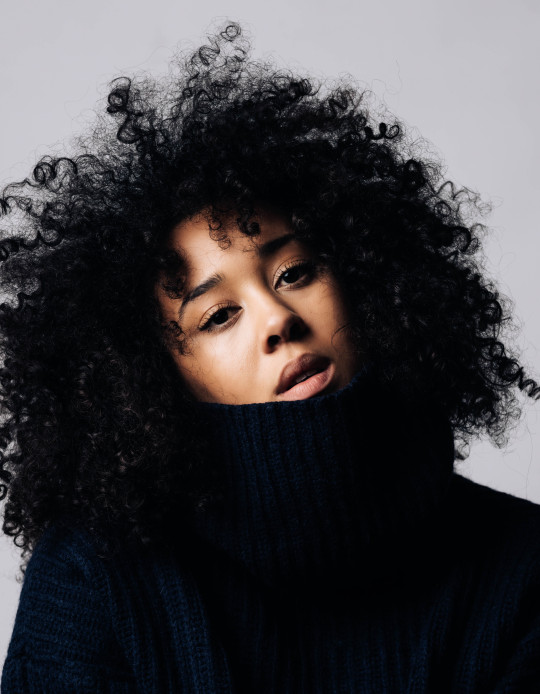
Images source: www.instagram.com/kennyjmw/
The IIIRD Citizen: thethirdcitizen.com
5 notes
·
View notes